This is a WiFi remote using a Esp8266 in the form of a Wemos D1 mini. It enables remote control of a Lay-z-Spa (3 wire model, #54075) via a Web API.
The following features can be controlled:
- Turn pump, heater and bubbles on / off
- Adjust temperature and max temperature
- View pump, heater and bubbles status
- View current temperature
- Lock temperature setting - revert any changes made by the control panel
- Auto-restart - the pump turns off after 24H, this will re-start the pump automatically
The following URIs are available:
| Uri | Method | Sample data |
|---|---|---|
| /autoRestart | POST | { "state": true } |
| /pump | POST | { "state": true } |
| /blower | POST | { "state": true } |
| /heater | POST | { "state": true} |
| /temperature/target | POST | { "value": 37 } |
| /temperature/limit | POST | { "value": 40 } |
| /temperature/lock | POST | { "state": true } |
| /status | GET | { "currentState": { "pumpState": 1, "temperature": 35 }, "targetState": { "pumpState": 3, temperature": 35 }, "autoRestart": true, "temperatureLock": true, "limitTemperature": 40, "errorCode": 0 } |
The following Topics are available:
| Topic | Sample Data |
|---|---|
| /hottub/cmnd/autoRestart | { "state": true } |
| /hottub/cmnd/pump | { "state": true } |
| /hottub/cmnd/blower | { "state": true } |
| /hottub/cmnd/heater | { "state": true } |
| /hottub/cmnd/temperature/target | { "value": 37 } |
| /hottub/cmnd/temperature/limit | { "value": 40 } |
| /hottub/cmnd/temperature/lock | { "state": true } |
On any state change a message containg the complete status is sent to the following topic: /hottub/state/status
The esp8266 connects to the hot tub via a 1 bit bus bidirectional transceiver (74LVC1T45 in this case).
The hot tub side is 5v, the esp8266 side is 3v3.
The switch in the circuit is to allow local programming, when rx is connected to d2 and the bus transceiver it prevents receiving serial data.

Front of the prototype board:
 Rear of the prototyp board:
Rear of the prototyp board:

This is the connector that the board plugs in to.
Red = 5v, Yellow = Data, Green = Gnd

All available commands were recorded using an OLS Logic sniffer and the signals.xml file was created using WaveMe